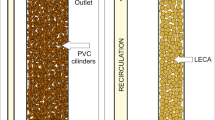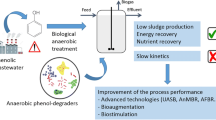Abstract
The intensive use of benzotriazoles as corrosion inhibitors for various applications and their application in dishwasher detergents result in an almost omnipresence of benzotriazole (BTri), 4-methyl- and 5-methyl-benzotriazole (4-TTri and 5-TTri, respectively) in aquatic systems. This study aims on the evaluation of the biodegradation potential of activated sludge communities (ASCs) toward the three benzotriazoles regarding aerobic, anoxic, and anaerobic conditions and different nutrients. ASCs were taken from three wastewater treatment plants with different technologies, namely, a membrane bioreactor (MBR-MH), a conventional activated sludge plant CAS-E (intermittent nitrification/denitrification), and CAS-M (two-stage activated sludge treatment) and used for inoculation of biodegradation setups. All ASCs eliminated up to 30 mg L−1 5-TTri and BTri under aerobic conditions within 2–7 and 21–49 days, respectively, but not under anoxic or anaerobic conditions. 4-TTri was refractory at all conditions tested. Significant differences were observed for BTri biodegradation with non-acclimated ASCs from MBR-MH with 21 days, CAS-E with 41 days, and CAS-M with 49 days. Acclimated ASCs removed BTri within 7 days. Furthermore, different carbon and nitrogen concentrations revealed that nitrogen was implicitly required for biodegradation while carbon showed no such effect. The fastest biodegradation occurred for 5-TTri with no need for acclimatization, followed by BTri. BTri showed sludge-specific biodegradation patterns, but, after sludge acclimation, was removed with the same pattern, regardless of the sludge used. Under anaerobic conditions in the presence of different electron acceptors, none of the three compounds showed biological removal. Thus, presumably, aerobic biodegradation is the major removal mechanism in aquatic systems.




Similar content being viewed by others
References
Buitrón G, Capdeville B (1995) Enhancement of the biodegradation activity by the acclimation of the inoculum. Environ Technol 16(12):1175–1184
Cancilla DA, Holtkamp A, Matassa L, Fang XC (1997) Isolation and characterization of microtox(R)-active components from aircraft de-icing/anti-icing fluids. Environ Toxicol Chem 16(3):430–434
Cancilla DA, Martinez J, Van Aggelen GC (1998) Detection of aircraft deicing/antiicing fluid additives in a perched water monitoring well at an international airport. Environ Sci Technol 32(23):3834–3835
Cervantes FJ, Gutiérrez CH, López KY, Estrada-Alvarado MI, Meza-Escalante ER, Texier A-C, Cuervo F, Gómez J (2008) Contribution of quinone-reducing microorganisms to the anaerobic biodegradation of organic compounds under different redox conditions. Biodegradation 19:235–246
Cheng C, Phipps D, Alkhaddar RM (2005) Treatment of spent metalworking fluids. Water Res 39(17):4051–4063
Cirja M, Ivashechkin P, Schäffer A, Corvini PX (2008) Factors affecting the removal of organic micropollutants from wastewater in conventional treatment plants (CTP) and membrane bioreactors (MBR). Rev Environ Sci Bio/Technol 7(1):61–78
Drillia P, Dokianakis SN, Fountoulakis MS, Kornaros M, Stamatelatou K, Lyberatos G (2005) On the occasional biodegradation of pharmaceuticals in the activated sludge process: the example of the antibiotic sulfamethoxazole. J Hazard Mater 122(3):259–265
Durjava MK, Kolar B, Arnus L, Papa E, Kovarich S, Sahlin U, Peijnenburg W (2013) Experimental assessment of the environmental fate and effects of triazoles and benzotriazole. Altern Lab Anim: ATLA 41(1):65–75
Ml F, Pérez S, Kantiani L, Barceló D (2008) Fate and toxicity of emerging pollutants, their metabolites and transformation products in the aquatic environment. TrAC Trends Anal Chem 27(11):991–1007
Field JA, Cervantes FJ, van der Zee FP, Lettinga G (2000) Role of quinones in the biodegradation of priority pollutants: a review. Water Sci Technol 42(5–6):215–222
Gruden CL, Dow SM, Hernandez MT (2001) Fate and toxicity of aircraft deicing fluid additives through anaerobic digestion. Water Environ Res 73(1):72–79
Harris CA, Routledge EJ, Schaffner C, Brian JV, Giger W, Sumpter JP (2007) Benzotriazole is antiestrogenic in vitro but not in vivo. Environ Toxicol Chem 26(11):2367–2372
Hart DS, Davis LC, Erickson LE, Callender TM (2004) Sorption and partitioning parameters of benzotriazole compounds. Microchem J 77(1):9–17
Hollender J, Zimmermann SG, Koepke S, Krauss M, McArdell CS, Ort C, Singer H, von Gunten U, Siegrist H (2009) Elimination of organic micropollutants in a municipal wastewater treatment plant upgraded with a full-scale post-ozonation followed by sand filtration. Environ Sci Technol 43(20):7862–7869
Janna H, Scrimshaw MD, Williams RJ, Churchley J, Sumpter JP (2011) From dishwasher to tap? Xenobiotic substances benzotriazole and tolyltriazole in the environment. Environ Sci Technol 45(9):3858–3864
Kadar E, Dashfield S, Hutchinson T (2010) Developmental toxicity of benzotriazole in the protochordate Ciona intestinalis (Chordata, Ascidiae). Anal Bioanal Chem 396(2):641–647
Kiss A, Fries E (2009) Occurrence of benzotriazoles in the rivers Main, Hengstbach, and Hegbach (Germany). Environ Sci Pollut Res Int 16(6):702–710
Kiss A, Fries E (2012) Seasonal source influence on river mass flows of benzotriazoles. J Environ Monit 14(2):697–703
Lesjean B, Gnirss R, Buisson H, Keller S, Tazi-Pain A, Luck F (2005) Outcomes of a 2-year investigation on enhanced biological nutrients removal and trace organics elimination in membrane bioreactor (MBR). Water Sci Technol 52(10–11):453–460
Liu Y-S, Ying G-G, Shareef A, Kookana RS (2011) Biodegradation of three selected benzotriazoles under aerobic and anaerobic conditions. Water Res 45(16):5005–5014
Liu Y-S, Ying G-G, Shareef A, Kookana RS (2012) Occurrence and removal of benzotriazoles and ultraviolet filters in a municipal wastewater treatment plant. Environ Pollut 165:225–232
Loos R, Gawlik BM, Locoro G, Rimaviciute E, Contini S, Bidoglio G (2009) EU-wide survey of polar organic persistent pollutants in European river waters. Environ Pollut 157(2):561–568
Loos R, Locoro G, Comero S, Contini S, Schwesig D, Werres F, Balsaa P, Gans O, Weiss S, Blaha L, Bolchi M, Gawlik BM (2010) Pan-European survey on the occurrence of selected polar organic persistent pollutants in ground water. Water Res 44(14):4115–4126
Matamoros V, Jover E, Bayona JM (2010) Occurrence and fate of benzothiazoles and benzotriazoles in constructed wetlands. Water Sci Technol: J Int Assoc Water Pollut Res 61(1):191–198
Müller E, Schüssler W, Horn H, Lemmer H (2013) Aerobic biodegradation of the sulfonamide antibiotic sulfamethoxazole by activated sludge applied as co-substrate and sole carbon and nitrogen source. Chemosphere 92(8):969–978
Nakata H, Murata S, Filatreau J (2009) Occurrence and concentrations of benzotriazole UV stabilizers in marine organisms and sediments from the Ariake Sea, Japan. Environ Sci Technol 43(18):6920–6926
Nakata H, Shinohara R-I, Nakazawa Y, Isobe T, Sudaryanto A, Subramanian A, Tanabe S, Zakaria MP, Zheng GJ, Lam PKS, Kim EY, Min B-Y, We S-U, Viet PH, Tana TS, Prudente M, Frank D, Lauenstein G, Kannan K (2012) Asia-Pacific mussel watch for emerging pollutants: distribution of synthetic musks and benzotriazole UV stabilizers in Asian and US coastal waters. Mar Pollut Bull 64(10):2211–2218
Pedrazzani R, Ceretti E, Zerbini I, Casale R, Gozio E, Bertanza G, Gelatti U, Donato F, Feretti D (2012) Biodegradability, toxicity and mutagenicity of detergents: integrated experimental evaluations. Ecotoxicol Environ Saf 84:274–281
Petrovic M, de Alda MJL, Diaz-Cruz S, Postigo C, Radjenovic J, Gros M (2009) Fate and removal of pharmaceuticals and illicit drugs in conventional and membrane bioreactor wastewater treatment plants and by riverbank filtration. Philos Trans R Soc A 367:3979–4003
Radjenovic J, Petrovic M, Barcelo D (2009) Fate and distribution of pharmaceuticals in wastewater and sewage sludge of the conventional activated sludge (CAS) and advanced membrane bioreactor (MBR) treatment. Water Res 43(3):831–841
Reemtsma T, Miehe U, Duennbier U, Jekel M (2010) Polar pollutants in municipal wastewater and the water cycle: occurrence and removal of benzotriazoles. Water Res 44(2):596–604
Reemtsma T, Weiss S, Mueller J, Petrovic M, Gonzalez S, Barcelo D, Ventura F, Knepper TP (2006) Polar pollutants entry into the water cycle by municipal wastewater: a European perspective. Environ Sci Technol 40(17):5451–5458
Sahar E, Ernst M, Godehardt M, Hein A, Herr J, Kazner C, Melin T, Cikurel H, Aharoni A, Messalem R, Brenner A, Jekel M (2011) Comparison of two treatments for the removal of selected organic micropollutants and bulk organic matter: conventional activated sludge followed by ultrafiltration versus membrane bioreactor. Water Sci Technol 63(4):733–740
Seeland A, Oetken M, Kiss A, Fries E, Oehlmann J (2012) Acute and chronic toxicity of benzotriazoles to aquatic organisms. Environ Sci Pollut R 19(5):1781–1790
Verheyen V, Cruickshank A, Wild K, Heaven MW, McGee R, Watkins M, Nash D (2009) Soluble, semivolatile phenol and nitrogen compounds in milk-processing wastewaters. J Dairy Sci 92(7):3484–3493
Vetter W, Lorenz J (2013) Determination of benzotriazoles in dishwasher tabs from Germany and estimation of the discharge into German waters. Environ Sci Pollut R 20(7):4435–4440
Voutsa D, Hartmann P, Schaffner C, Giger W (2006) Benzotriazoles, alkylphenols and bisphenol A in municipal wastewaters and in the Glatt River, Switzerland. Environ Sci Pollut R 13(5):333–341
Weiss S, Jakobs J, Reemtsma T (2006) Discharge of three benzotriazole corrosion inhibitors with municipal wastewater and improvements by membrane bioreactor treatment and ozonation. Environ Sci Technol 40(23):7193–7199
Weiss S, Reemtsma T (2008) Membrane bioreactors for municipal wastewater treatment—a viable option to reduce the amount of polar pollutants discharged into surface waters? Water Res 42(14):3837–3847
Wolschke H, Xie Z, Möller A, Sturm R, Ebinghaus R (2011) Occurrence, distribution and fluxes of benzotriazoles along the German large river basins into the North Sea. Water Res 45(18):6259–6266
Zhang Z, Ren N, Li Y-F, Kunisue T, Gao D, Kannan K (2011) Determination of benzotriazole and benzophenone UV filters in sediment and sewage sludge. Environ Sci Technol 45(9):3909–3916
Acknowledgment
Financial support by the Bavarian State Ministry of the Environment and Public Health (StMUG) is gratefully acknowledged.
Author information
Authors and Affiliations
Corresponding author
Additional information
Responsible editor: Hongwen Sun
Rights and permissions
About this article
Cite this article
Herzog, B., Lemmer, H., Huber, B. et al. Xenobiotic benzotriazoles—biodegradation under meso- and oligotrophic conditions as well as denitrifying, sulfate-reducing, and anaerobic conditions. Environ Sci Pollut Res 21, 2795–2804 (2014). https://doi.org/10.1007/s11356-013-2199-3
Received:
Accepted:
Published:
Issue Date:
DOI: https://doi.org/10.1007/s11356-013-2199-3




